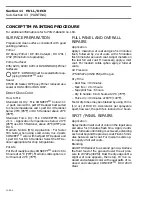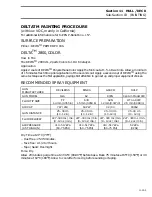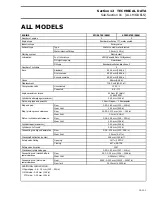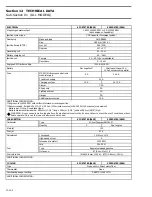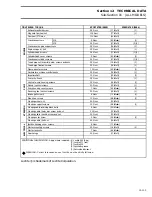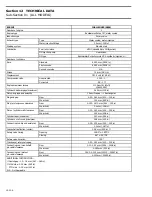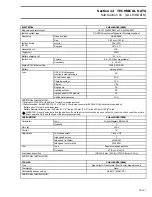
Section 11
HULL / DECK
Sub-Section 02
(REPAIR)
11-02-1
REPAIR
2
HULL AND DECK REPAIR
GENERAL
Gelcoat is the smooth and durable cosmetic finish
which coats the fiberglass hull and body of a Sea-
Doo jet boat. It also provides a protective barrier
against water and sun. It consists of a mixture of
resin, pigment (coloring), fillers, monomers and
catalyst which is sprayed into the mold.
The body and hull of the Sea-Doo jet boat are con-
structed of chopped fiberglass, saturated with
resin. It is sprayed on the layer of gelcoat along
with pieces of fiberglass mat, cloth and woven
rowing which are added at required areas. This
type of construction is very accommodating for
high quality repairs. With patience, the proper
techniques and materials, a damaged area can be
restored to an original finish.
The content is not intended to replace the use of
a complete fiberglass and gelcoat repair manual.
Its main purpose is to help you understand what
factors are involved when making a damage as-
sessment or estimate.
NOTE :
Fiberglass repair kit is available
through automotive or marine suppliers.
Gelcoat repair kits are available through regular
channel. Refer to SERVICE TOOLS AND PROD-
UCTS 01-03 section.
WARNING : Protect skin, wear gloves
when in contact with resin, hardeners and
gelcoat. A barrier skin cream may also be used.
Do not expose area to open flame or lit ciga-
rette. Some of the materials are flammable.
Protect eyes, wear safety glasses when grind-
ing, sanding or spraying. Use a dust mask
when sanding or grinding. When spraying
wear a respirator or paint mask. Always read
warning labels on products.
AIR BUBBLES
Possible Cause
– Air pocket trapped between layers of laminate
and gelcoat.
1) Preparation of Surface
Remove all of the damaged gelcoat surrounding
the air bubble with a putty knife or preferably a
carbide grinding tip. Make sure all loose and weak
areas are completely removed. Sand a small area
of the gelcoat surface with 220-grit sandpaper. If
needed, sand the cavity itself. These areas must
have a rough surface to allow the gelcoat putty to
bond properly.
2) Filling the Cavity
The prepared surface must be cleaned with ace-
tone on a cloth. Use the Bombardier gelcoat repair
kit (P / N 295 500 100). Follow the mixing instruc-
tions in the kit when preparing the gelcoat putty.
Carefully mix the required amount while making
sure there are no air bubbles in the mixture. With
a putty knife fill the repair area and cover with
plastic film. Curing time may depend on tempera-
ture, amount of putty and percentage of catalyst.
After 2 hours, press lightly on the surface with fin-
gers to test the hardness. When the area be-
comes hard, remove the plastic film.
3) Sanding
Begin block sanding the patch with 320-grit sand-
paper until you come close to the original surface.
Remove dust with a water soaked cloth and con-
tinue sanding with a 400-grit wet paper. Finish
wet sanding with a 600-grit to remove deeper
scratches. If needed you can wet sand with finer
grit paper such as 1000-grit.
4) Buffing and Waxing
Buff the surface using a heavy duty polisher with
a buffing pad. Make sure the pad is free of dirt or
you may damage the gelcoat. Carefully begin
buffing with a white medium compound RM 856.
Finish off using a fine RM 852 compound. While
buffing, pay close attention to avoid overheating
the surface.
'
;
Summary of Contents for Challenger 5896
Page 1: ......
Page 2: ......
Page 3: ...219 100 044 0 0 0 1996 Shop Manual 0 R ...
Page 152: ...Section 08 ELECTRICAL Sub Section 03 IGNITION SYSTEM 08 03 2 ELECTRICAL BOX Sportster F04H11S ...
Page 154: ...Section 08 ELECTRICAL Sub Section 03 IGNITION SYSTEM 08 03 4 ELECTRICAL BOX Speedster F04H26S ...
Page 251: ...Section 11 HULL DECK Sub Section 01 COMPONENTS 11 01 5 F04L3IS Loctite 242 ...
Page 274: ......






















